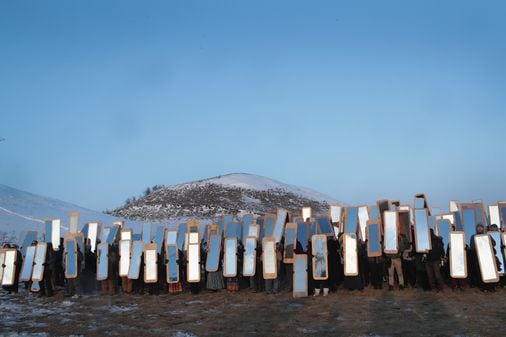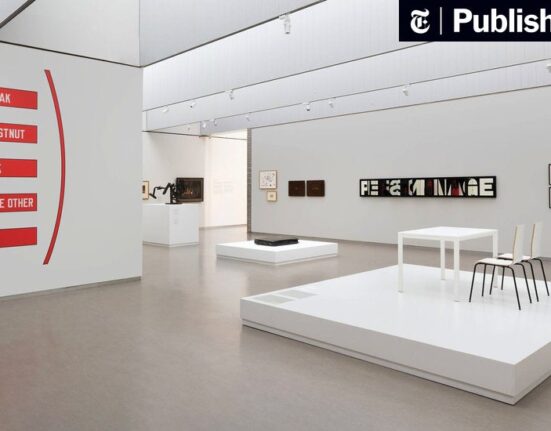Kenwyn Crichlow’s debut exhibition at Diane Rosenstein,“Incandescence,” has a lot of history behind it. After three decades as an artist and educator in Trinidad and Tobago, Crichlow is being reintroduced to the Los Angeles gallery scene. The show spans his early impressionistic experiments and more recent abstractions in charged, vivid hues, which aspire to tell universal truths.
The exhibition comes with a growing interest in Crichlow’s work across the U.S.: His paintings in the gallery’s booth at Independent 20th Century this past fall attracted attention from well-known collectors, curators, and journalists alike. Now, Diane Rosenstein, which recently announced representation of Crichlow, is staging a large suite of paintings on the gallery’s walls.
For the most part “Incandescence” highlights Crichlow’s latest endeavors. He painted 10 of the show’s 16 pieces in the past five years. The gallery’s signature alcoves, like those of chapels, host conversations between these new large abstractions and rarely-seen paintings from the 1970s. Also on view is Blue Epic: Silence (1989), which was previously shown in California when it was part of “Caribbean Visions,” a stereotype-shattering exhibition that toured the U.S. in 1995.
Crichlow discovered his artistic talent as a teen, just years after Trinidad and Tobago gained independence. He found community in the Southern Arts Society, a group of artists who convened in Trinidad during the 1970s—until he ventured abroad to study at Goldsmiths, in London, upon receiving a scholarship.
“I gave up representation during my time in London to move towards abstract representation,” Crichlow told Artsy, “where the ideas could be broadened, where you ask the viewer to look at the work in the same way, perhaps, as they listen to words.” Crichlow graduated in London at the top of his class, which earned him a spot at Yale. He declined the place, however, returning home instead to work, teach, and contribute to Trinidad’s art community.
A triptych, Kissing the Horizon (2006–10) marks the point where Crichlow embraced a larger, more immersive scale. The piece began as a diptych, but the artist realized it needed something more, and turned into a triptych. “There is a vitality in the painting that reached out to me,” Crichlow recalled. In this work, solar bursts of yellow light stream from deep red clouds. Sensual forms evoke supple flesh along the undulating horizon line, like distinct tempos unified by one long, dramatic song.
Situated opposite in the adjacent alcove is Power to the People (1974), inspired by Crichlow’s experience witnessing Trinidad and Tobago’s Black Power movement. The work’s placement underscores its smaller scale, clearer figuration, and comparatively muted tones. This painting typifies Crichlow’s style not only in its loose lines and abstract symbols, but also in the rhythmic punctuation of its flattened scene, scored like a crowd’s escalating pitch with text.
Artists throughout Trinidad and Tobago have faced unique challenges establishing their identities post-independence. Colonial-era paintings prioritized the gentry, but as Trinidad and Tobago transitioned from a plantation to tourism-based economy, art still catered to leisure. “We’ve been preoccupied with questions of representation of a society that is African, Indian, European, Chinese,” Crichlow said. “How to represent the society in its complexity?” But these artists have long since come into their own—and Crichlow is still working among them.
The artist’s latest paintings include Fire of Desire (2020), with its golden blaze and earthy jewel tones. The work’s surface gives a sense of crackling, with a brittle, painterly application. Meanwhile, Still in love and Trembling Shadows in a Trackless Place (both 2023) look like watercolors from the cascading oil washes that cover their surfaces, like glassy lakes.
Trinidad’s ecosystem is visible in Crichlow’s paintings through botanical accents like mangroves as well as unflinching bold hues indicative of light on the island, which is 10 degrees north of the equator. Older works like Mother and child (1974) evidence Crichlow’s lifelong affinity for color and harmonizing individuality within a whole. Beside it, Blackened Earth: The Hope For Freedom (2022–23), a brilliant tangle of rainbow-hued lines, shows the power of this continuous thread in his practice.
Crichlow considers this the opportune moment for his re-introduction on the U.S. gallery scene because of how the Caribbean and wider worlds are changing. “I would like these paintings to be part of that transformation,” he remarked.







